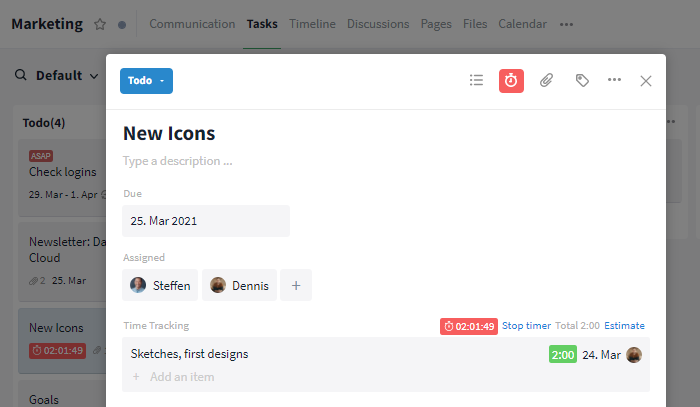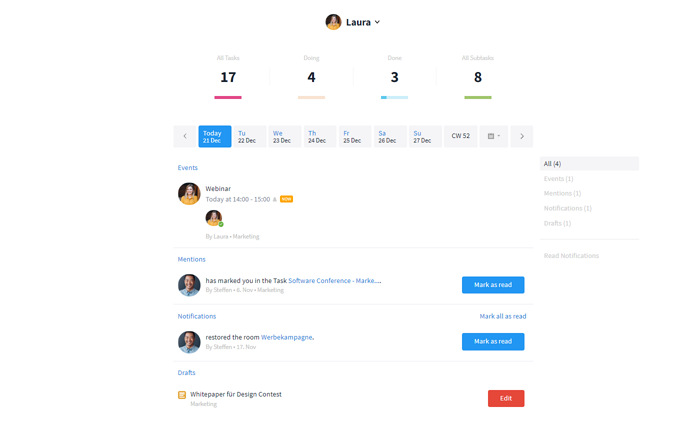Do you ever feel like there just aren’t enough hours in the workday? Your desk is piled with tasks, meetings constantly disrupt your workflow, and by the end of the day, it feels like you haven’t really accomplished anything. The key to overcoming this challenge lies in effective time management.
With mindful planning, you can handle tasks more efficiently, reduce stress, and create more productive workdays. In this article, you'll discover proven time management techniques, understand why they’re especially crucial in project management, and learn how digital tools like Stackfield can help you make the most of your time.
What is time management?
Time management is the intentional organization of tasks to make the most of the time available. The goal isn’t to schedule every minute but to set clear priorities and minimize distractions. Effective time management boosts productivity, reduces stress, and creates space for focused work.
Without a structured approach, tasks often get postponed, pile up, or even slip through the cracks – leading to overwhelm and inefficiency. Time management techniques help streamline workflows and give you better control over your daily routine.
What do I gain from good time management?
There are many benefits to good time management
- Increased productivity: A structured approach allows you to accomplish more in less time.
- Reduced stress: Better planning prevents last-minute scrambles and unnecessary overtime.
- Higher-quality work: Focusing on what truly matters leads to greater precision and fewer mistakes.
Without effective time management, important tasks can be neglected while trivial ones consume too much time. Conscious planning helps prevent these pitfalls and ensures you stay on top of your workload.
What time management methods are there?
There are many strategies to help you use your time more efficiently. Here are some tried-and-tested methods:
Kanban Method 📝
Kanban is a visual task management system that originated in manufacturing but is now widely used in project management. Tasks are organized into columns representing different work stages, such as:
- To Do (tasks yet to be started)
- In Progress (tasks currently being worked on)
- Completed (finished tasks)
Individuals or teams move tasks from one column to the next until they’re completed.
Tip: Stackfield includes a built-in Kanban board view, making it easy to manage and track tasks visually and efficiently.
Eat the Frog 🐸
Start your day by tackling the most difficult or unpleasant task first. This prevents procrastination and eliminates the anxiety of having it loom over you all the time.
This method is based on the idea that people naturally avoid challenging tasks, which can lead to unnecessary stress. By handling them first, you free your mind and set a productive tone for the rest of the day.
Example: If writing reports is a struggle for you, make it the first thing you do in the morning to relieve the pressure and move forward with a sense of accomplishment.
Tip: Identify your "frog" the night before so you can straight away in the morning.
Eisenhower Method ⏳
The Eisenhower Method helps prioritize tasks based on urgency and importance, making it clear what needs immediate attention and what can be delegated or ignored.
Tasks are categorized into four groups:
- Urgent and important → Do it immediately
- Important but not urgent → Schedule it
- Urgent but not important → Delegate it
- Neither urgent nor important → Ignore it
Example: A critical client meeting falls into category 1, while organizing your desk typically belongs in category 4.
Pomodoro Technique 🍅
The Pomodoro Technique boosts productivity and focus through structured work intervals. It involves working in 25-minute sessions, followed by a 5-minute break. After four rounds, take a longer break of 15 to 30 minutes.
This method works on the principle of time limitation: knowing you only need to focus for 25 minutes helps maintain motivation and reduces distractions. The short breaks also prevent mental fatigue.
Tip: Use a timer or an app to stick to the rhythm. This technique is particularly effective for deep-focus tasks.
40-30-20-10 Rule 📊
This rule divides your available time into four segments, providing a clear guideline for how much time to allocate to tasks of varying importance:
- 40% for the most important task
- 30% for medium-priority tasks
- 20% for smaller tasks
- 10% for unexpected tasks or breaks
Tip: These percentages don’t need to be rigid – adjust them based on your workload and task complexity.
ALPEN Method 🗻
The ALPEN (german name for the Alps mountain range) method follows five steps to ensure structured and efficient time management:
- List all tasks
- Estimate how long each task will take
- Plan buffer time (about 40% of your schedule)
- Establish priorities and make decisions
- Review and adjust as needed
This method promotes realistic planning, prevents overload, and reduces time pressure. It helps maximize available time while improving overall productivity. The ALPEN method is especially useful for those who struggle with structuring their day or tend to get sidetracked.
How does Stackfield help you with time management?
Stackfield offers a range of features to support various time management techniques, including:
Time Tracking:

Time tracking in Stackfield
Stackfield’s integrated time tracking feature allows users to accurately record the time spent on tasks. This is invaluable for both structuring your own workday and managing projects, as it provides a clear overview of progress and helps identify potential bottlenecks early on.
One of the key advantages of Stackfield’s time tracking function is the ability to analyze recorded data afterward. Users can generate detailed reports that offer insights into time spent on different tasks and projects. This transparency not only enhances personal productivity but also simplifies project tracking and billing processes.
Task and Project Management:

A Kanban board in Stackfield
Stackfield simplifies task planning, delegation, and tracking. The Kanban board, a standard view in the task overview, is ideal for visually managing tasks, setting priorities, and structuring workflows efficiently.
Tasks can be assigned due dates, labels, and reminders to ensure nothing is overlooked. Team members can also comment on tasks, attach files, and share status updates, fostering transparent collaboration.
Focus and Prioritization:

The "My week" overview in Stackfield
Stackfield helps users concentrate on the most important tasks. With features like deadlines and reminders, tasks can be organized by urgency, enabling more focused work. The personal dashboard "My Week" provides a clear, up-to-date overview of outstanding tasks.
Additionally, the integrated calendar module allows tasks to be scheduled alongside meetings and appointments, making it easier to structure the workday and allocate sufficient time for high-priority work.
Collaborative work:

The team chat in Stackfield
Stackfield enhances teamwork through shared rooms, task lists, and structured data management, reducing redundancy and improving information flow.
The platform also offers multiple communication options, including team chats or integrated audio and video calls. This allowes teams to connect directly within Stackfield, eliminating the need for external tools.
Conclusion: You can maximize your time with the right tools
Time management is more than just an organizational skill – it is a strategy for working more productively, calmly, and with greater focus. By planning, prioritizing, and structuring their time effectively, individuals can prevent burnout and enhance the quality of their work. The methods outlined here demonstrate that there’s a suitable approach for every working style – whether it is clear prioritization with the Eisenhower Matrix, mindful time management with the Pomodoro Technique, or visual task organization with Kanban.
In a world full of distractions, maintaining focus is more important than ever. Digital tools like Stackfield provide valuable support, helping to optimize workflows and seamlessly integrate time management strategies into daily work.
Once you start managing your time intentionally, you will quickly realize that a well-structured day not only boosts productivity but also makes work feel significantly more effortless and rewarding.